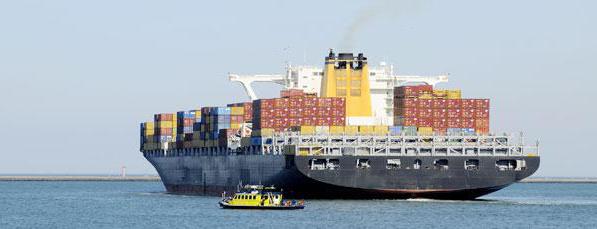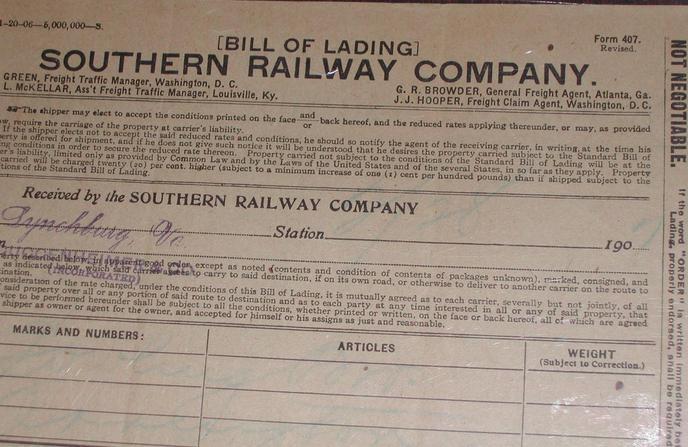A bill of lading is a document issued by the carrier to the owner of the goods. Its key feature is that the exercise of rights under it is possible only with the physical provision of the original. Copy, electronic and other forms of the document do not have legal force. Next, consider the types and functions of the bill of lading.

General information
A bill of lading is a security expressing ownership of a particular product specified in it. It is considered an analogy. waybill. It contains the terms of the contract for sea transportation. Bill of Lading - this is a document allowing the holder to dispose of the load. It is issued after the recipient has accepted the transported objects. This document in practice confirms the conclusion of an agreement. The procedure in accordance with which the bill of lading is executed is established by the Merchant Shipping Code. The document is issued for any cargo, regardless of the method of transportation. Material assets can be delivered with the provision of the entire vessel, certain premises or without this condition at all. Having a customs bill of lading, the carrier carries out transportation according to the Hague rules. They are present in International convention dated August 25, 1924. The laws of states may establish other transportation rules.
Tasks
Based on the properties described above, we can say that a bill of lading is a document used as:
- Receipts of the carrier in the receipt of goods for transportation with a simultaneous description of its visually assessed condition.
- Waybill.
- Confirmation of the contract of carriage.
- Document of title.
A bill of lading can also act as a loan guarantee for shipped items.

Specificity
In the process of transportation of goods, as well as during the period of storage, there is a temporary alienation from the owner. This fact implies a loan relationship. However, it is not expressed in the form of loans. In this regard, a bill of lading is a document having properties similar to the characteristics of a warehouse certificate.
Signs
The bill of lading is a security:
- Debt.
- Non-issuing.
- Documentary.
- Profitless.
- Urgent. The period of its existence will depend on the duration of the transportation.
- Nominal, order or bearer. It depends on the type of warehouse certificate.
- Nominated. The face value is not the amount of money, but the actual amount of cargo transported.
The document under consideration must be accompanied by an insurance policy for the transported goods. In addition, the transfer of the bill of lading may be accompanied by the compilation (statement) of additional certificates. They may relate directly to the transport of goods, their storage, preservation. These documents may be required during customs clearance. The list of necessary certificates for moving cargo across the border is established by interstate agreements and the laws of specific countries.

Mandatory details
No changes are allowed in the document. Forms of bills of lading must contain a number of obligatory details. Among them, of particular importance are:
- String Shipper. It indicates the name of the shipper and its location.
- String Port of Discharge. The port of discharge is entered in this column in accordance with the contract for sea transportation.
- Consignee string.It indicates the name of the consignee and its location.
- Description of Packages And Goods String. This column contains the characteristics of the cargo that are necessary for its identification (this is the mass, number of seats, etc.). In addition, there may be indications of its danger or specific properties. If the goods are sent in several containers with one bill of lading, the quantity and weight must be entered in each of them.
This information is indicated by the shipper. The carrier (agent of the sea, feeder, ocean line) also enters certain data. In particular, he indicates in the bill of lading:
- Own name.
- In the line Port of Loading - port of loading.
- In the column Number of Original - the number of originals of the bill of lading.
- Place and date of issue of the document.

Main types
Initially, a bill of lading was used when transporting cargo exclusively by sea. Currently, it is also used when moving goods in other ways. In this case, the document is called pass-through. There are also the following varieties of bill of lading:
- Linear. It contains the will of the sender to conclude a contract for the carriage of goods.
- Charter. This document is issued to confirm the acceptance of goods that are transported under a charter contract. It is an agreement to hire a ship for a specific flight or for a certain period. Such a bill of lading does not act as a basis for drawing up a contract for the carriage of goods by sea. In such cases, separate charter agreements are entered into.
Both of these bills of lading determine the relationship between the carrier of the goods and the third party - the holder of the document. It acts as a receipt, which the transporter gives to the sender in confirmation that the objects have been accepted for delivery, and together with this document of title. In this case, the conditions of sale and other operations in relation to the goods are carried out using a bill of lading without actually transferring the goods themselves.
Received for shipment
A bill of lading for placement on board the vessel confirms the acceptance of goods - delivery under the protection of the ship. After loading, the shipowner provides a document certifying that the facilities are ready for transportation. It is called the on-board bill of lading. The shipowner can also link the document with the name of the ship, the date at the port of shipment, indicating that the goods were accepted by him. Such paper should have the same properties as the on-board bill of lading.

Clean bill of lading
The clean bill of lading does not contain any additional notes or clauses that directly state the defectiveness of the goods or its packaging. As a rule, such a document indicates that the objects are apparently in good condition. In the international banking system, in case of accreditation, as a general rule, bills of lading must be clean, unless otherwise specified in the conditions of a documentary letter of credit.
Claused (reservations)
In some cases, a bill of lading is issued with a reservation. In such a document, the ship's captain notes the circumstances relating to visible defects in packaging or cargo. In other words, he points to inconsistencies with the loading order. Such a document is accepted at the bank if the terms of payment contain an accurate description of the notes or reservations that are valid.
Through bill of lading
A through bill of lading is provided if sea transportation makes up only a certain part of the general route or is carried out by two or more lines. In such situations, it is more convenient for the sender to draw up one document than to conclude a separate contract with each carrier. The sender, who issues the bill of lading, interacts only with the carrier that signs it. The transporter organizes reloads with subsequent delivery.For this he charges freight (extra charge).
Custody B / L (coastal act)
A document that is issued in confirmation of the acceptance of objects on the shore (usually at the carrier’s warehouse) is called a coastal bill of lading. When placing the cargo in respect of which it was issued, a corresponding note is made in it that the goods have been accepted, the date is indicated and other material entries are made. In some cases, a coastal bill of lading is replaced by an onboard bill of lading.
Home bill of lading
This document is prepared to prevent various problems associated with the transportation of goods. It is also used if:
- It is necessary to hide the path and the real client.
- The sender or agent provides additional services that are not provided for in the field of shipping.
- Freight was purchased from a carrier that does not have its own ships, but is part of NVOCC, and this company needs to hide the movement and the actual client for a particular load.
- A document is required before loading the goods on board. For example, this situation occurs if the sender uses a credit scheme in his work.
Important point
As mentioned above, certain details must be present in the bill of lading. In their absence, the document will not be deemed to be of title. In this case, the bill of lading ceases to act as a security. An extract of the document is carried out in several copies. One of them is provided to the sender. When you issue the goods in one of the copies, all the others lose their legal force.
Recipient Status
Depending on how this subject is defined, a bill of lading can be:
- Ordering.
- Named.
- Bearer.

The first is issued when a specific person has the right to control who exactly to deliver the goods to. This possibility is fixed by the words to order ("by order") in the Consignee line. If this person is not indicated, then the bill of lading will be deemed "by order of the sender." The name document contains recipient information in the Consignee column. The line indicates the name of a particular subject. Bearer bill of lading does not contain any specific data regarding the person entitled to receive the goods. In this regard, in the port of destination, the objects must be given to any entity that presented the document. Bearer bill of lading is rarely used, as any holder acts as the legal consignee.
Additionally
The bill of lading serves the turnover during transportation. Therefore, interested parties to the relationship can transfer it without any restrictions. On this basis, all bills of lading are considered negotiable. The difference between them is the way in which it is provided by one person to another. When compiling a document, its price is determined, among other things. It is set in accordance with the value of the cargo to be transported and the amount of expenses for its transportation.








